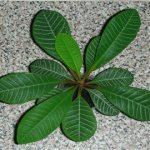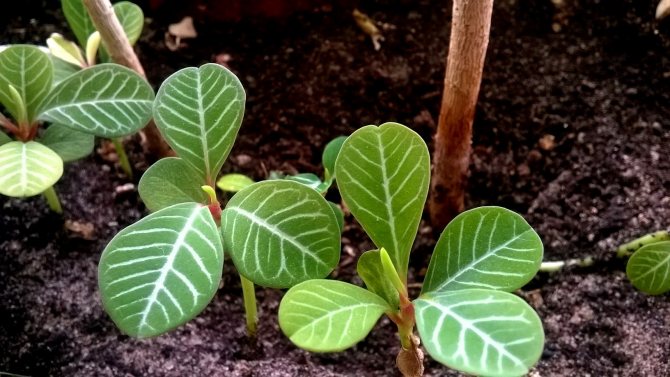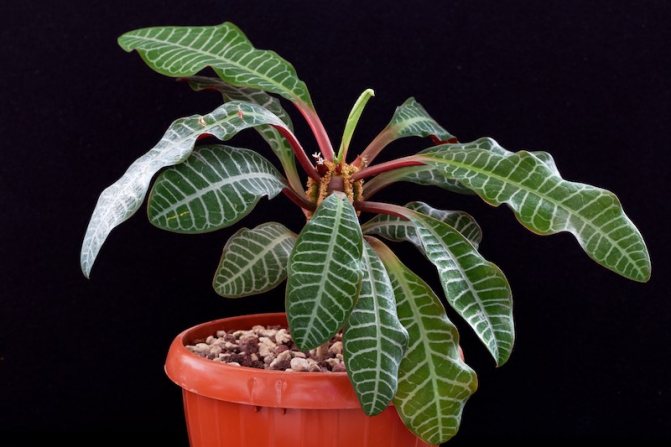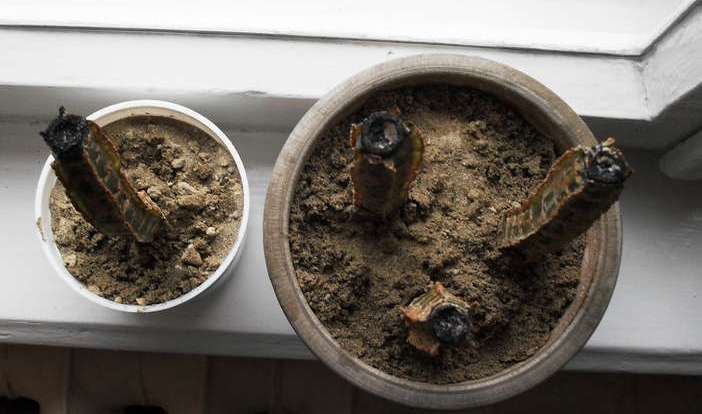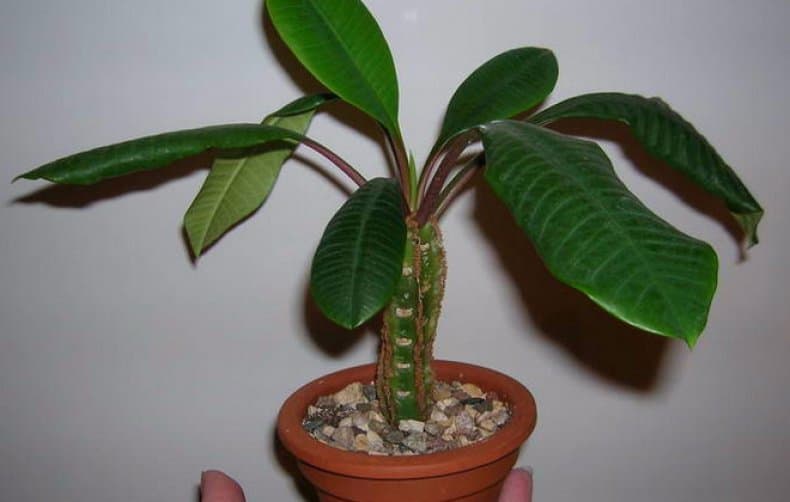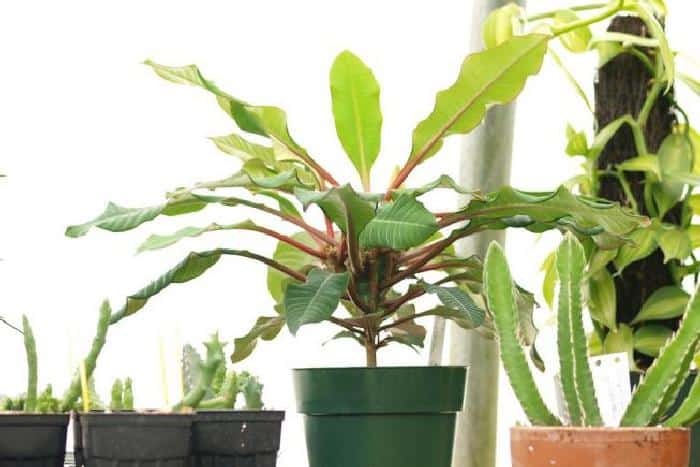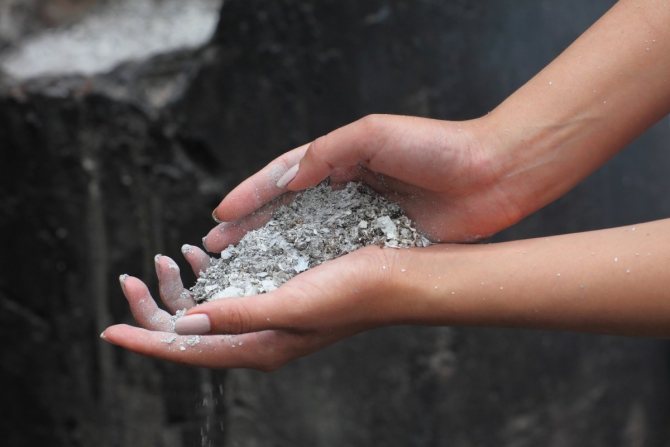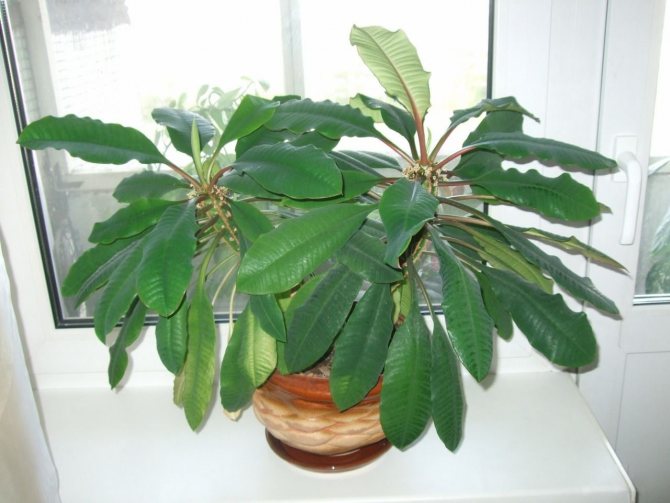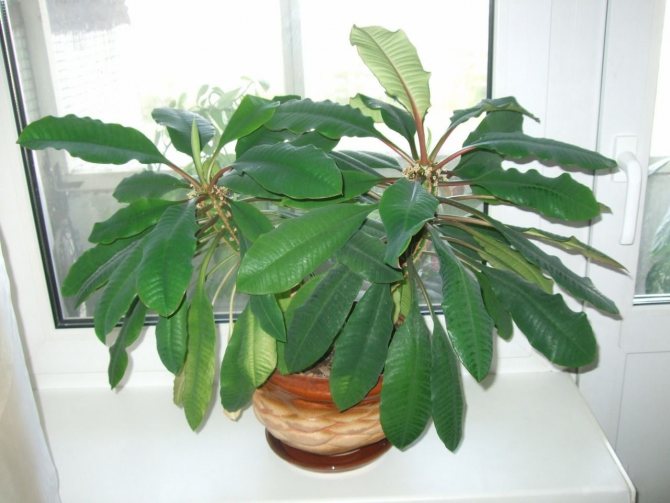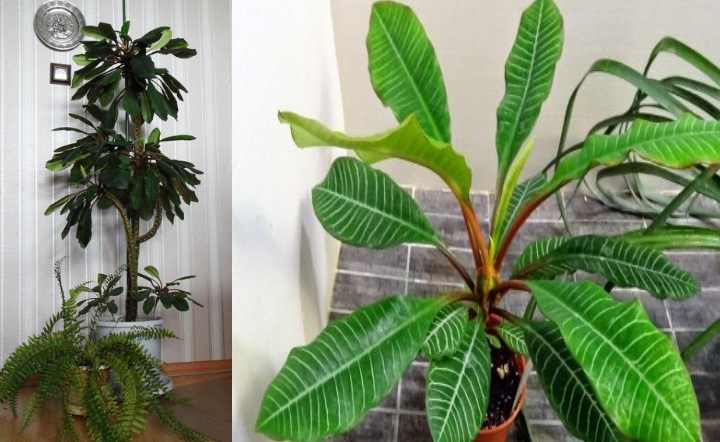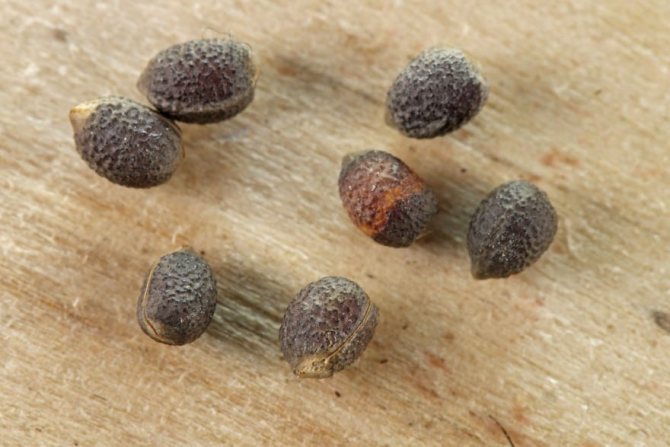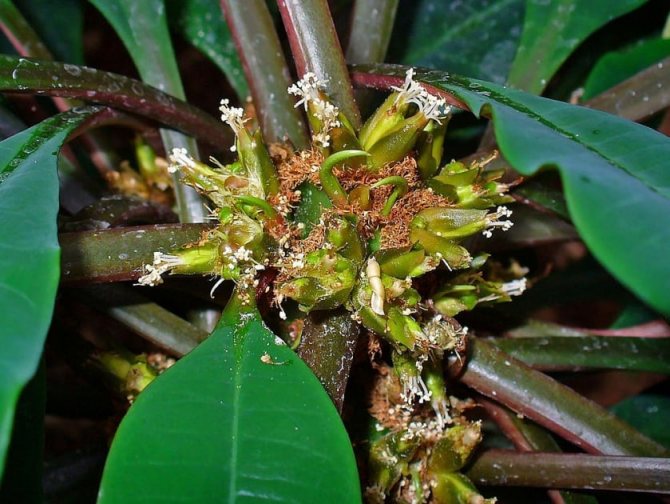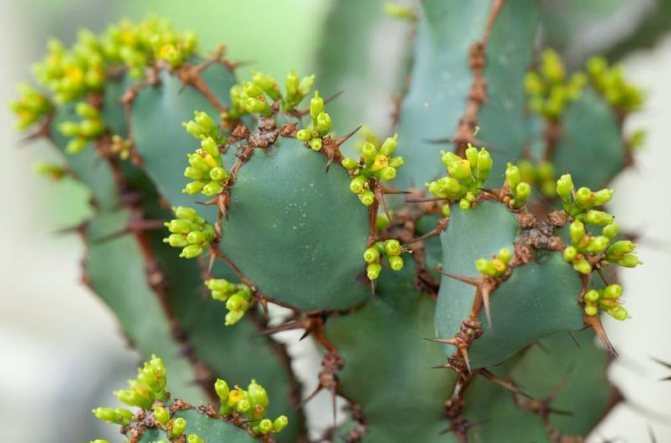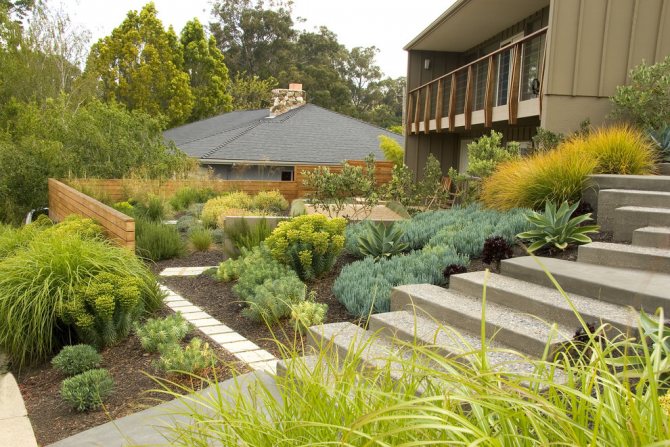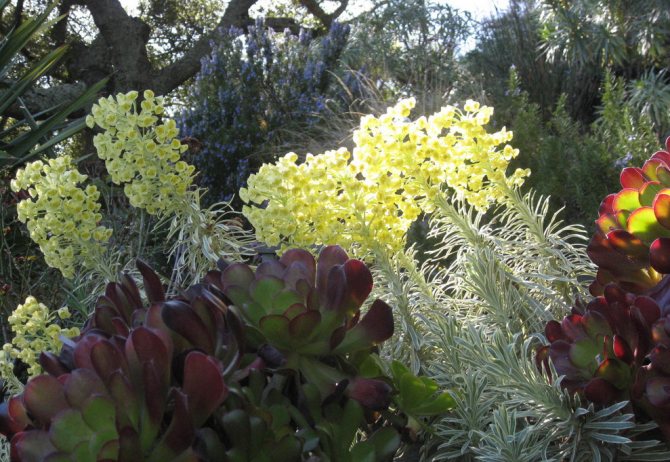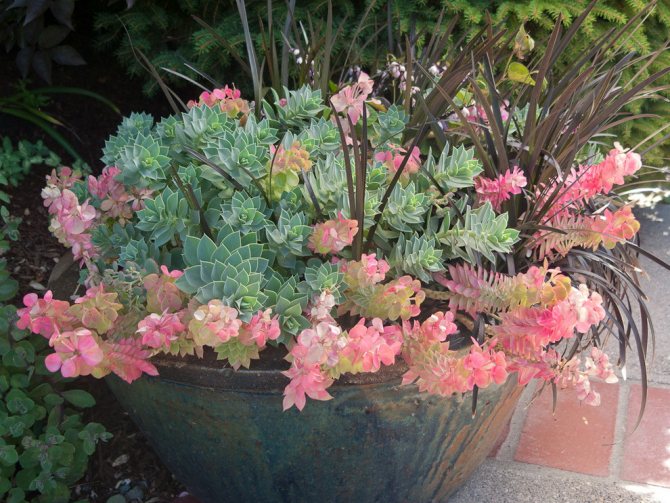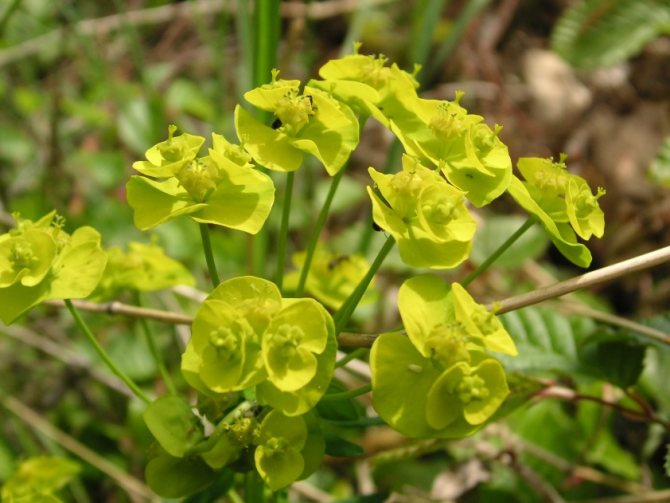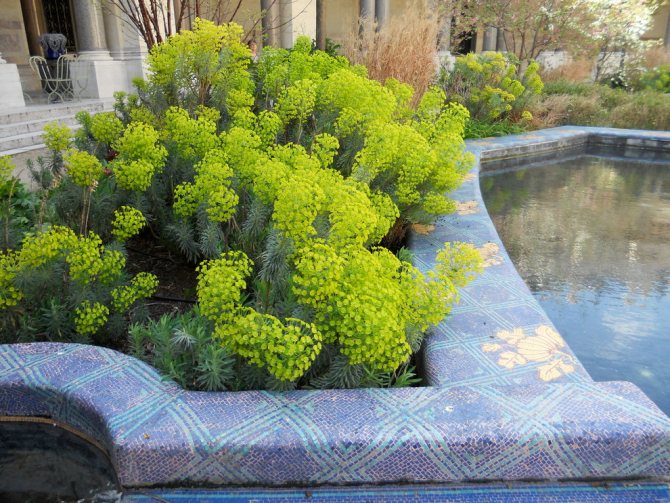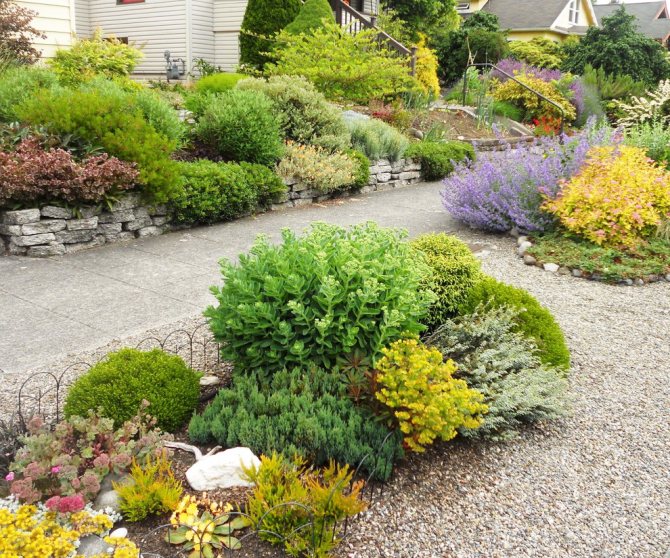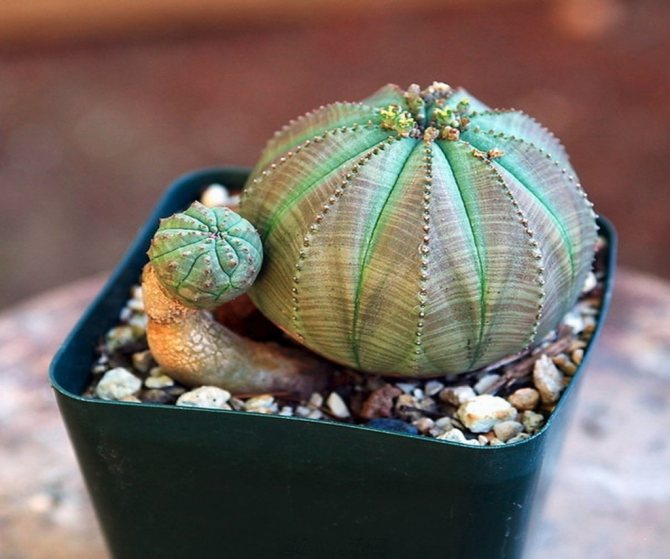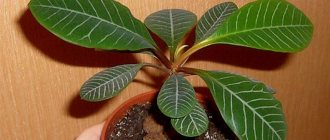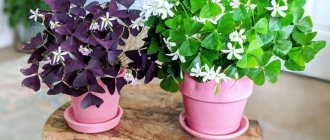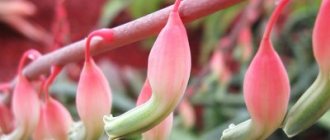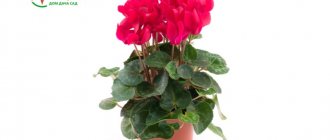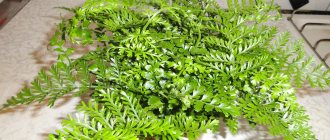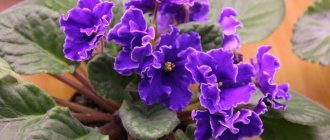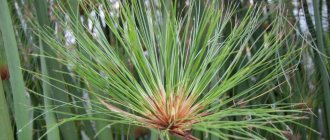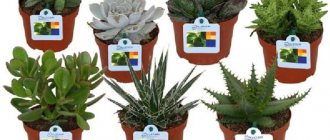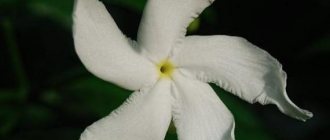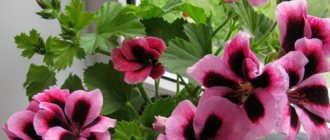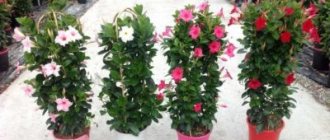Experienced flower growers have probably heard of such an indoor plant as euphorbia. Despite the fact that it is distinguished by a large species diversity, the most famous among its species is the white-tailed spurge. Some people mistake it for a cactus because it has a thick stem, while others associate it with a palm tree at all, which can be explained by the presence of lush foliage at the top of the trunk.
It is not always possible to distinguish white-tailed euphorbia from other species, for example, comb euphorbia, the first time. To understand what kind of milkweed is in front of you, you should carefully look at the veins... They will be clearly visible in the white-veined one. In addition to this, this type of milkweed resembles a palm tree, and also stands out for its more pronounced decorative properties.
- 2 Home care
2.1 Main activities
- 2.2 Creating an enabling environment
Botanical characteristic
The Latin name of the genus was given in honor of the doctor Euphorba. The historical record states that the doctor served at the court of the Numidian ruler Yubu II in the first century AD. and he cured many diseases with this plant.
In nature, whole forests of euphorbia grow, but not so long ago the flower became an adornment of the interior and greenhouses all over the world. Today it can be found in almost every home or apartment.
Euphorbia white-veined is so named for the leaves with noticeable white-silver veins. With age, the latter darken and the flower becomes not so "sinewy". The petioles remain brownish. As the stem grows, the lower leaves fall off, leaving peculiar scars. When cut, a whitish sap is released from the leaf blades.
The species belongs to stem succulents, despite the decorative crown on the crown, which suggests tropical trees.
This exotic houseplant will decorate any corner, because it grows quite large - at home it reaches 1-1.5 m.
The trunk is round, fleshy, woody from below with age. Small brown spines are located on the ribs. At the top there is a rosette of green oval large leaves up to 15 cm long.
In the future, young leaves grow gradually at the top. Branching only begins in adulthood. This perennial plant does not lose its attractiveness for 10-15 years. Blooming is rather inconspicuous - with small light flowers.
The smell of nectar is not perceptible for a person, but insects will quickly flock to the palm tree in the open air.
Description
The birthplace of milkweed is Madagascar... Now it is found in subtropical America and Africa.
Stem
The lower part is round, dense, thin. It thickens upwards, becomes ribbed, usually has 4-5 ribs, along the edge of which there are fringed stipules. Gradually, with growth, the trunk is exposed from below. With proper care, a white-veined (white-veined) euphorbia indoor flower can grow up to two meters.
Leaves

Dark yellow leaves have white streaks, grow on long petioles that have a reddish color, they themselves are also long, there are up to 20 cm.
Young leaves grow at the top, on the crown, which makes the plant look like a palm tree.
Flower
Flowering is not among the merits of this succulent.
Bracts consist of hard scales, from which flowers peep out, similar to thin white threads. Whole flower looks extremely nondescript.
Fetus
After the end of flowering, a box remains, which has three nests inside, where the seeds ripen. After the seeds are fully ripe, it cracks, the seeds are scattered in different directions and germinate quickly in all nearby pots. For this, spurge is also popularly called “splashes of champagne". If there is a need to collect seeds, then it is necessary monitor the ripening of the capsule and have time to take it off before it cracks.
To avoid abundant self-seeding, the flowers will have to be carefully torn off, twisting clockwise and removing the milky juice with a damp cloth.
Purchase and adaptation
Before purchasing, the plant should be inspected for damage, strange stains, or plaque that could indicate disease. You do not need to take a specimen whose leaves are crumbling or turning yellow.
After the purchase, the flower must be transplanted, because the store substrate is not suitable for permanent maintenance at home.
Euphorbia quickly adapts to the new microclimate, however, it is important to be quarantined for two weeks after purchase and to keep it separate to avoid inadvertently contaminating other plants at home.
The necessary conditions
Selection of soil and location
Indoor flower is preferable to grow on the southwestern, southeastern, southern windowsills. This herb looks good in compositions with cacti. It feels good next to radiators and other heating devices.
Remember! Spurge is poisonous, so it is better to place it away from children and animals.
The soil should have excellent air permeability and neutral acidity. You can purchase a special substrate for succulents or prepare it by combining in equal parts brick chips, calcined sand and small pebbles, turf and peat soil.
Humidity
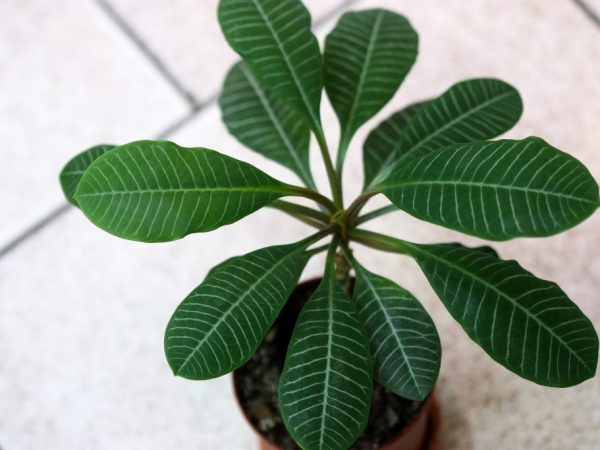

The flower does not need to be sprayed
Euphorbia tolerates dry air well, but cultivation is optimal at 40-50% humidity. High humidity can negatively affect the condition of the plant, so it is recommended to brush away dust from leaves with a dry cloth or brush.
Temperature
It is recommended to keep the indoor "palm" at 15-25⁰С. In summer, you can take the flowerpot out into the fresh air. It is necessary to protect the euphorbia from hypothermia. Insignificant differences will not affect the condition of the flower, but drafts must be avoided.
Euphorbia blooms after a dormant period, which begins when the temperature drops to 12-14⁰С. At this time, buds are laid. The best months for "wintering" are from October to February.
Lighting
This succulent is photophilous and can withstand even the direct action of sunlight, but in the summer, the rays can provoke burns, so at noon it is advisable to shade the green pet from the scorching sun.
It is better to put the flowerpot in a secluded corner with good diffused lighting, and in winter you will have to organize additional lighting with phytolamps, otherwise the leaves will fade and the growth of the tree will slow down.
Optimal watering
Also, optimal plant care should include a special irrigation regime and an indicator of air humidity.
It is important to remember that our culture came from Mexico, where the air is dry. This type of plant is considered drought-resistant; you need to moisten the soil in a pot no more than two times every seven days.
It is important to wait until the soil is completely dry.
In winter, the culture rests, so watering should be reduced several times. Experts recommend watering the plant for a novice florist when the topsoil is completely dry. It is also forbidden to allow overdrying of the root system.
In addition, it will be better to dry the flower than to excessively moisturize. If you water the culture regularly and with plenty of water, then as a result this will lead to decay of the rhizomes. Without rehabilitation of the condition, the flower can die very soon. While complete drying of the soil in the pot can lead to yellowing and early fall of the leaves.
You also need to pay attention to humidifying the air around and spraying the plant. The mile grows well and develops in a room with dry air - this is a big plus for apartment owners
But the room still needs to be regularly ventilated. This will be very useful for both the grower himself and the culture. In winter, the pot must be kept away from heaters, and spraying is generally prohibited. Watering the culture, you need to be careful, since water drops should not fall on the leaves and other parts of the plant. Most often this leads to fungal diseases.
Home care
Fertilizers and feeding
Propagation by cuttings and seeds, flowering, active growth require additional strength from the plant.
During warmer months, it is recommended to add cactus additives once a month when watering. Fertilizers are not used in autumn and winter.
During the flowering period, potash dressings are used.
Watering
Watering is carried out according to the following mode:
- in the summer - 2-3 times a week;
- in winter - once every 20 days - a month;
- at temperatures below 12⁰С watering is not performed.
Euphorbia is a succulent, therefore waterlogging can lead to decay - all moisture is already stored in the stem. But drying out also cannot be allowed.
If the soil is excessively dry, then water is added gradually.
The water should not be cold, preferably at room temperature or warm. It is better to drain the excess liquid from the pallet.
Transfer
The transplant is carried out with the onset of the warm season. For young specimens - annually, for mature ones - once every 2 years or as the root system grows.
Before starting the procedure, the flower is watered. When removing a plant from an old pot, you do not need to forcefully clean off the soil from the roots - let the excess crumble by itself.
A transplant is necessary in the following cases:
- after purchase in a store;
- with overgrowth or decay of roots;
- if the soil is infected with parasites.
Pruning
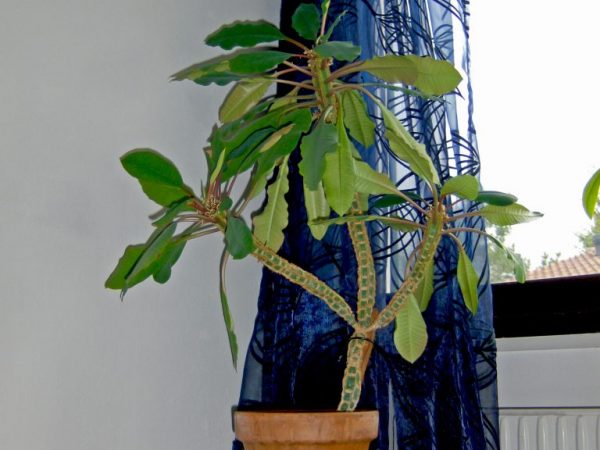

Pruning stimulates the growth of side shoots
It is not necessary to prune the spurge. Formative pruning is performed in the following cases:
- if it is necessary to shorten deformed shoots and too high a bush;
- to make the flower more magnificent;
- to stimulate branching.
To do this, the top is trimmed with a sharp knife in spring or summer with a frequency of once every couple of years. The knife should be wiped with alcohol in advance. The released juice is washed off with warm water, and the place of the cut is sprinkled with coal.
Container for milkweed
For milkweed, fairly wide pots or flowerpots are required, since it has a superficial root system. It is best to use a short but wide container.
It is worth noting the importance of drainage, because the soil needs to breathe, and moisture should not stagnate in it for too long. For such purposes, a pot that has holes in the bottom is best.
As soon as the plant begins to grow, it is transplanted into containers in which the bottom is lined with flat large pebbles. They play the role of a counterweight, since the fragile root without them will not be able to hold the stem and leaves.
Reproduction methods
It is quite easy to grow new specimens both from seeds and by propagation by cuttings.
Seeds
Propagation is easy in this way - after flowering, "boxes" with the appropriate content are formed.
Note! Euphorbia shoots seeds - this is how self-sowing occurs in nature.To avoid losing the seeds, wrap the pods with a cloth beforehand or simply scoop out the seedlings from the mother's pot.
Sowing is carried out in moistened soil after preliminary soaking. The container is covered with foil. Further, periodic spraying and airing of the seedlings is required.
The emergence of seedlings from fresh, good quality seeds will have to wait about 10 days. It is advisable to store seeds for no more than 1 year.
Cuttings
Reproduction by cuttings is carried out in early summer:
- the shoot (shoot with a leaf node 12-15 cm long) must be cut off;
- the released juice is washed off;
- the cut is sprinkled with crushed coal and air-dried for 1-2 days;
- the shoot should be rooted in a moist peat mixture and placed in a warm place with good lighting, covered with a plastic cap, sprayed periodically;
- then it remains to transplant the grown plant into the appropriate pot about 2 weeks after the procedure.
By dividing an adult plant
Reproduction by dividing an adult tree is carried out in the off-season. To do this, it is enough to carefully divide the mother bush and transplant the resulting specimens. Places of cuts are treated with water and sprinkled with coal powder. This is a very traumatic method, so complete rooting and recovery can take place only after a year or two.
Diseases and pests
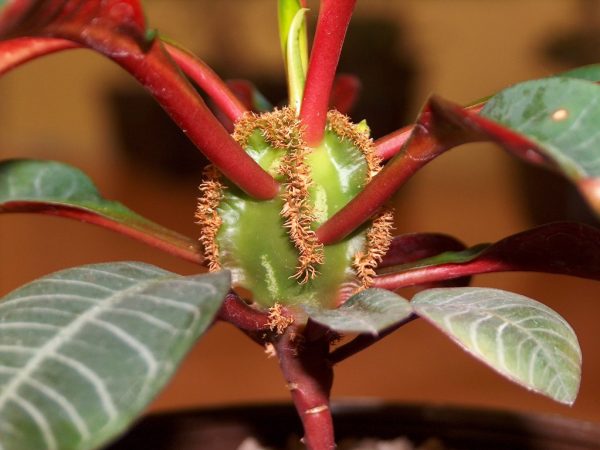

Proper care will keep the plant healthy
| Disease | Symptoms | Treatment | Prophylaxis |
| Decay of roots | Leaves turn yellow and fall, fall off, roots darken and become slimy. | Trimming damaged parts, replanting to clean soil. | Proper care, periodic check of the condition of the plant, compliance with quarantine for new specimens. |
| Drafts, hypothermia, violations of the schedule of nutrient introduction, lighting, watering | Turn yellow, discolor, leaves fall off, shoots stretch out. | Appropriate care must be provided. | |
| Whitefly | Whitish spots on the leaves, insects on the back of the leaf blade, wilting. | Spraying with insecticides, removing infected parts. | |
| Aphid | Curling of leaves, blanching. | ||
| Mealybug | The dying off of the leaves, the flower stops growing and developing, insects are found on the roots during transplantation. | Watering and flushing the roots with insecticides, transplanting into a new land. | |
| Spider mite | Spiderweb bloom on the leaves. | Treatment with soapy water or appropriate insecticides. |

